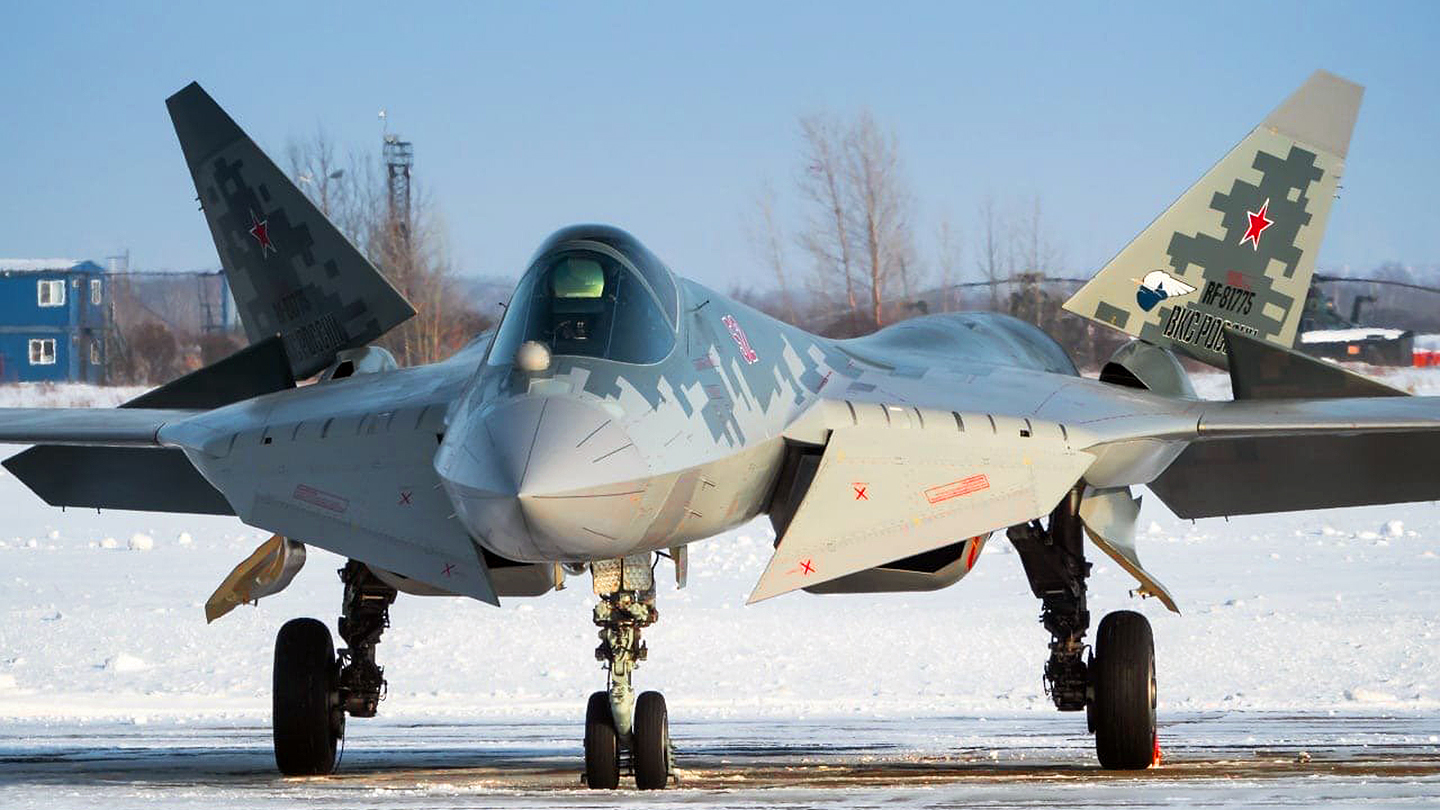Russia has “almost certainly used” its Su-57 Felon new-generation fighter in its war against Ukraine, according to an assessment from the U.K. Ministry of Defense (MOD). While the assertion is not backed up by any irrefutable publicly available evidence, it’s not the first time that it’s been claimed that Russia’s most advanced fighter jet has been playing some kind of a role in the war.
In its latest Defense Intelligence update today, the U.K. MOD focuses exclusively on the Su-57 as part of its regular situation report on the war in Ukraine.
The sources upon which the U.K. MOD’s evaluation is based are not disclosed, but the ministry states that the Su-57 has very likely been employed in combat “since at least June 2022.” Interestingly, unconfirmed claims of the Felon being used in the conflict have actually been surfacing since before that date, most notably in a report from Russia’s state-run TASS news agency last May. Citing an unnamed “defense industry source,” the Tass report claimed that “the use of Su-57 aircraft in Ukraine began two to three weeks after the start of the special operation” — as the invasion of Ukraine is described by the Kremlin.
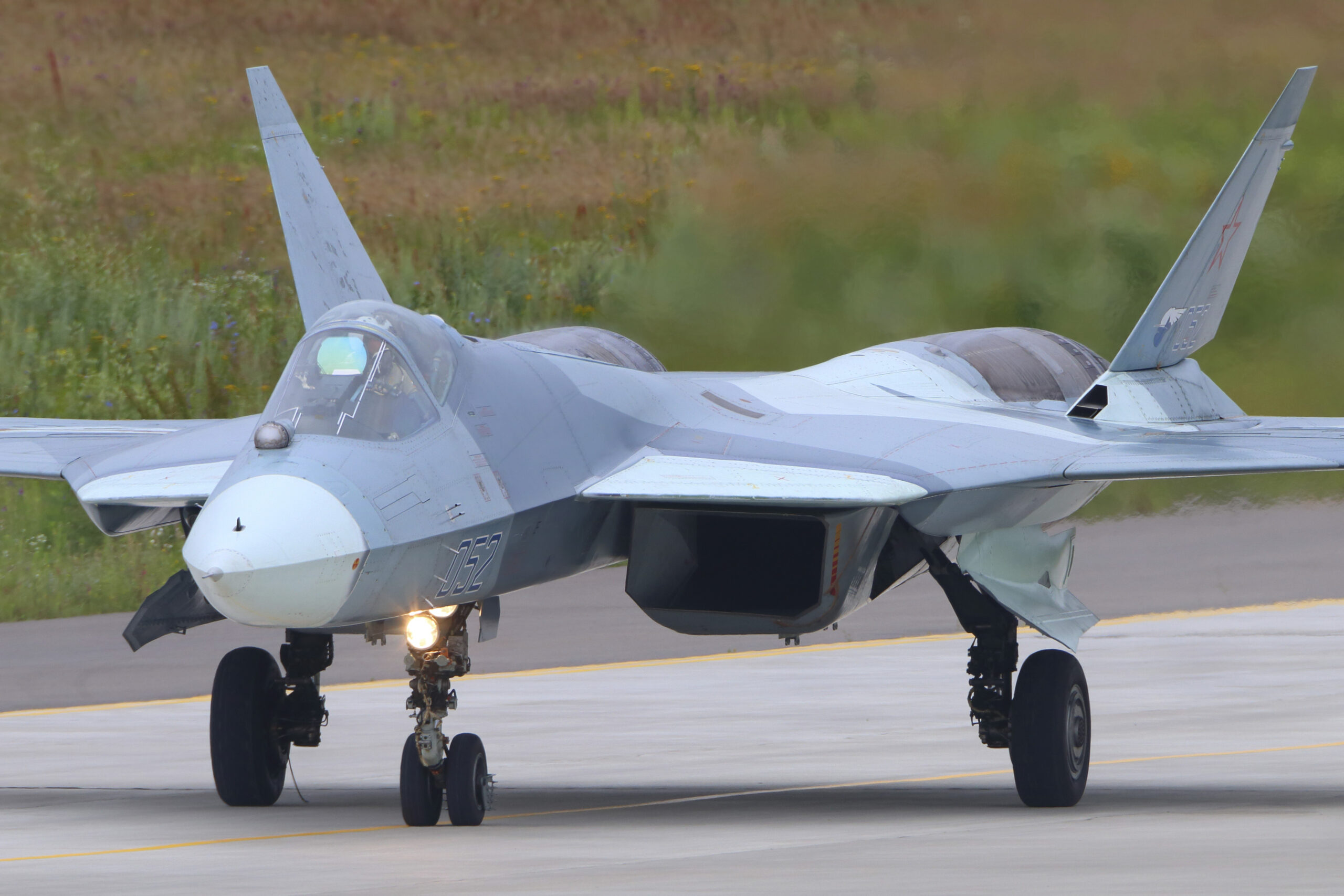
“These missions have likely been limited to flying over Russian territory, launching long-range air-to-surface or air-to-air missiles into Ukraine,” today’s U.K. MOD assessment continues. This would go a long way to explaining why there is currently no open-source confirmation of Su-57s operating over Ukraine itself. It would also fit in with the kind of missions that have been flown by other Russian fighters with long-range armament, namely the Su-35S Flanker and the MiG-31BM Foxhound, which you can read more about here.
On its Twitter channel, the U.K. MOD also provides an example of a “commercially available” satellite image, dated December 25, showing five Felons at the Russian airbase at Akhtubinsk, near Astrakhan, in southern Russia. The accompanying information notes that the base is home to the 929th Flight Test Center and that “this is the only known Felon base,” meaning that “these aircraft have likely been involved in operations against Ukraine.”
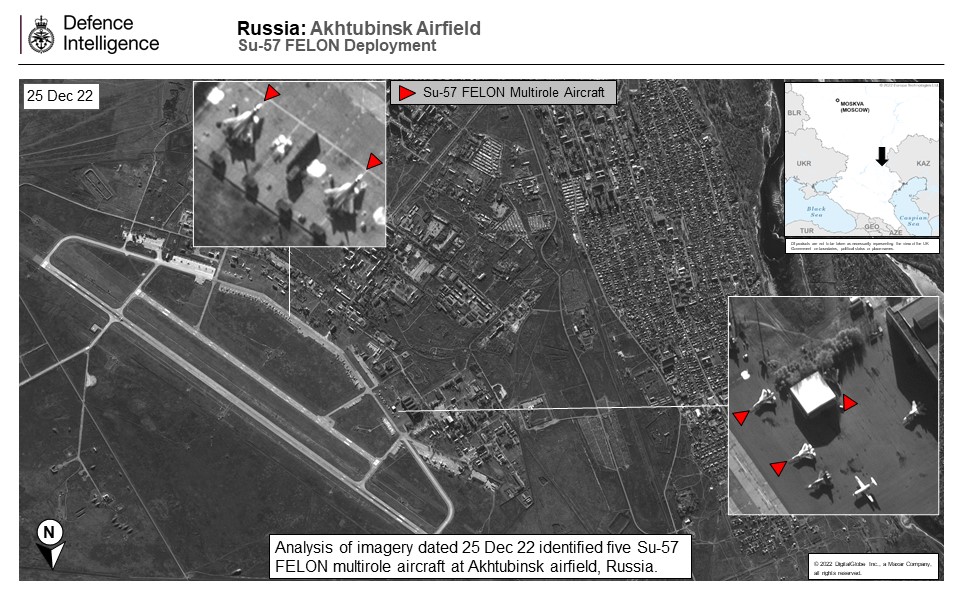
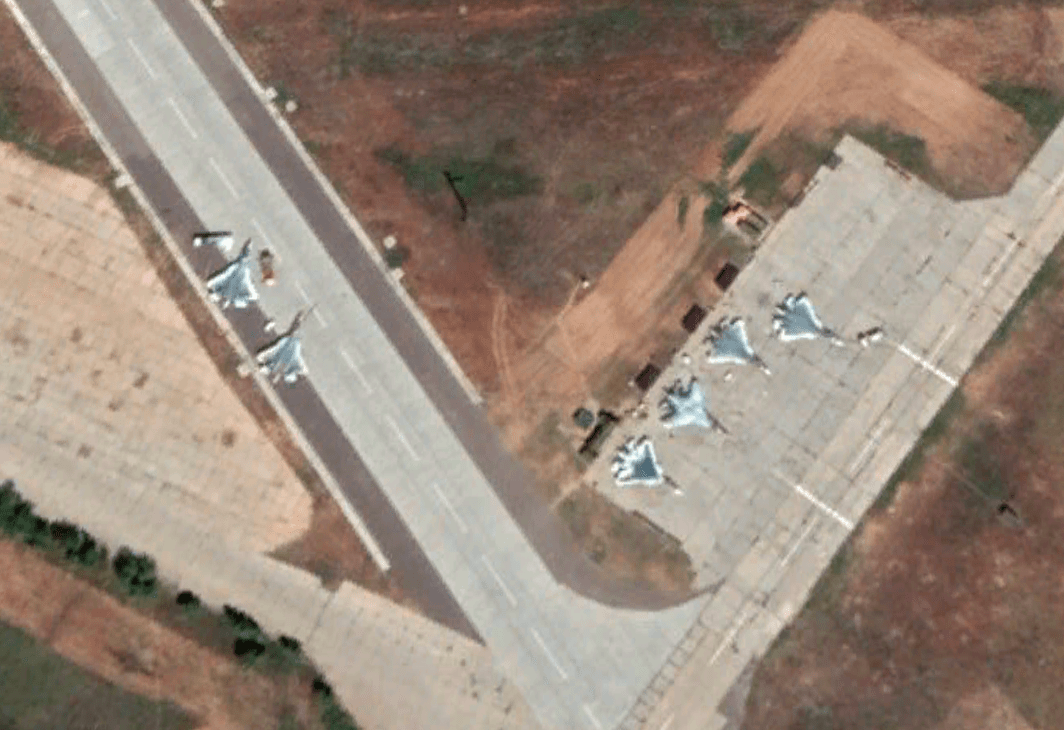
While there is no disputing the presence of Su-57s at Akhtubinsk, it’s hard to see how this fact alone can be used as evidence of them being employed in the war in Ukraine. Akhtubinsk is not only home to a wide variety of different Russian Aerospace Forces combat jets, but it’s also not the only airbase that accommodates Su-57s. As The War Zone has noted in the past, Lipetsk has also received examples of the jet.
The most important responsibility of the 929th State Flight-Test Center at Akhtubinsk is the official state evaluation of military aircraft, upgrades, and equipment, ensuring they meet their stated requirements, after which they can formally enter service.

Meanwhile, Lipetsk’s 4th State Air Personnel Preparation and Military Evaluation Center, or 4 GTs PAP VI MO RF, to give its Russian acronym, is tasked with the evaluation of initial batches of tactical combat aircraft, developing tactics, and training pilots in combat application of the aircraft. It’s here that the first cadre of frontline Su-57 pilots are currently being trained on the type, which will then enter operational service with the 23rd Fighter Aviation Regiment based at Dzyomgi near Komsomolsk-on-Amur in Russia’s Far East. You can read more about those plans and that unit here.
As it is, Akhtubinsk is not the “only known Felon base” and, even if it were, that would not be evidence of the Su-57 being used operationally in the Ukraine war. However, if the Felon has been used in combat, the U.K. MOD almost certainly has much more compelling evidence than what it has shared up to this point.
The United Kingdom and its allies are watching Russia’s air war very closely. All types of intelligence gathering are brought to bear in doing so. This includes everything from satellite imagery to signals and human intelligence. They also work closely with Ukrainian intelligence and the country’s air force, which have first-hand accounts of Russian aerial activities on a daily basis. Allies, especially the U.S., monitor everything in the sky they can see from nearby NATO borders. Suffice it to say, if Su-57s are operating, they would know about it.
“Russia is highly likely prioritizing avoiding the reputational damage, reduced export prospects, and the compromise of sensitive technology which would come from any loss of Felon over Ukraine,” the U.K. MOD account continues. These considerations would almost certainly come into play if the Su-57 was indeed being used in the conflict. After all, this is Russia’s most advanced fighter and includes a significant amount of highly sensitive technology. On the other hand, the very long range of the Su-57’s weapons and sensors (especially when compared with opposition Ukrainian fighter jets), means they could still play useful a role in the conflict without actually overflying Ukrainian territory, or at least penetrating deeply into it, for more limited operations.
“This is symptomatic of Russia’s continued risk-averse approach to employing its air force in the war,” the account concludes. Speaking to The War Zone back in March 2022, Ukrainian Air Force MiG-29 pilot “Juice” recounted: “You know you need just two or four Su-30s or Su-35s against [the Ukrainians’ MiG-29s and Su-27s], but 12? Sometimes there are even more, sometimes we saw around 24 jets in the air near the border, trying to shoot our jets.”
Again, while there is plenty of evidence that Russian airpower has indeed pivoted to being used in a highly conservative manner, keeping Su-57s, and other combat aircraft capable of long-range air-to-air or air-to-surface engagements, within Russian airspace does make some sense. Why risk a Su-57 in highly contested Ukrainian airspace when it can achieve some effects outside of it? On the other hand, the claimed low-observable characteristics, even if somewhat limited, and powerful sensor suite of the Su-57 should enable it to excel once it has penetrated Ukrainian airspace and gets closer to its targets. In this sense, holding Su-57s (and other tactical airpower assets) back clearly reduces their effectiveness, removing the option to directly attack targets or to attempt to achieve air superiority in any meaningful fashion.
In the case of the Felon, the 124-mile-range R-37M (AA-13 Axehead) air-to-air missile is of particular relevance for standoff scenarios. This is a weapon that one Ukrainian fighter pilot describes as “fucking dangerous” and which apparently first began to appear in combat last summer. A compressed-carriage version is also being developed for the Su-57, although its status is unclear. However, even the R-77-1 (AA-12 Adder), with its range of 68 miles, would be capable of engaging Ukrainian aircraft ‘over the border’ in some scenarios. Meanwhile, the K-77M that is also being developed for the Su-57 is reported to have double the range of the basic R-77; that would imply a range of up to 100 miles for the new weapon. You can read more about both these various new-generation weapons here.
Aside from some powerful air-to-air missiles, the Su-57 could make its presence felt in the Ukrainian theater by using air-to-ground munitions, in particular, those offering standoff range. These include the Kh-69 stealthy cruise missile, intended to destroy small, hardened targets at distances of over 180 miles, and the Kh-58UShK anti-radiation missile with a maximum range of around 150 miles, depending on launch parameters. With precision-guided munitions of all kinds in huge demand within the Russian military, it could be the case that the Su-57 has been called upon in this regard out of necessity.
Another major facet of the Su-57 is its ability to leverage its advanced sensor suite and communications datalinks, operating as a kind of electronic intelligence and command and control asset, in a similar kind of way to the F-35 Joint Strike Fighter and F-22. It could help provide real-time intelligence and support other aircraft operations in real-time. Even using voice radio communications, it could help ‘quarterback’ the fight with other less advanced fighters.
Again, while the appearance of the Su-57 in the latest U.K. Defense Intelligence update at this point is somewhat surprising, it’s by no means the first such suggestion of its use in combat in Ukraine.
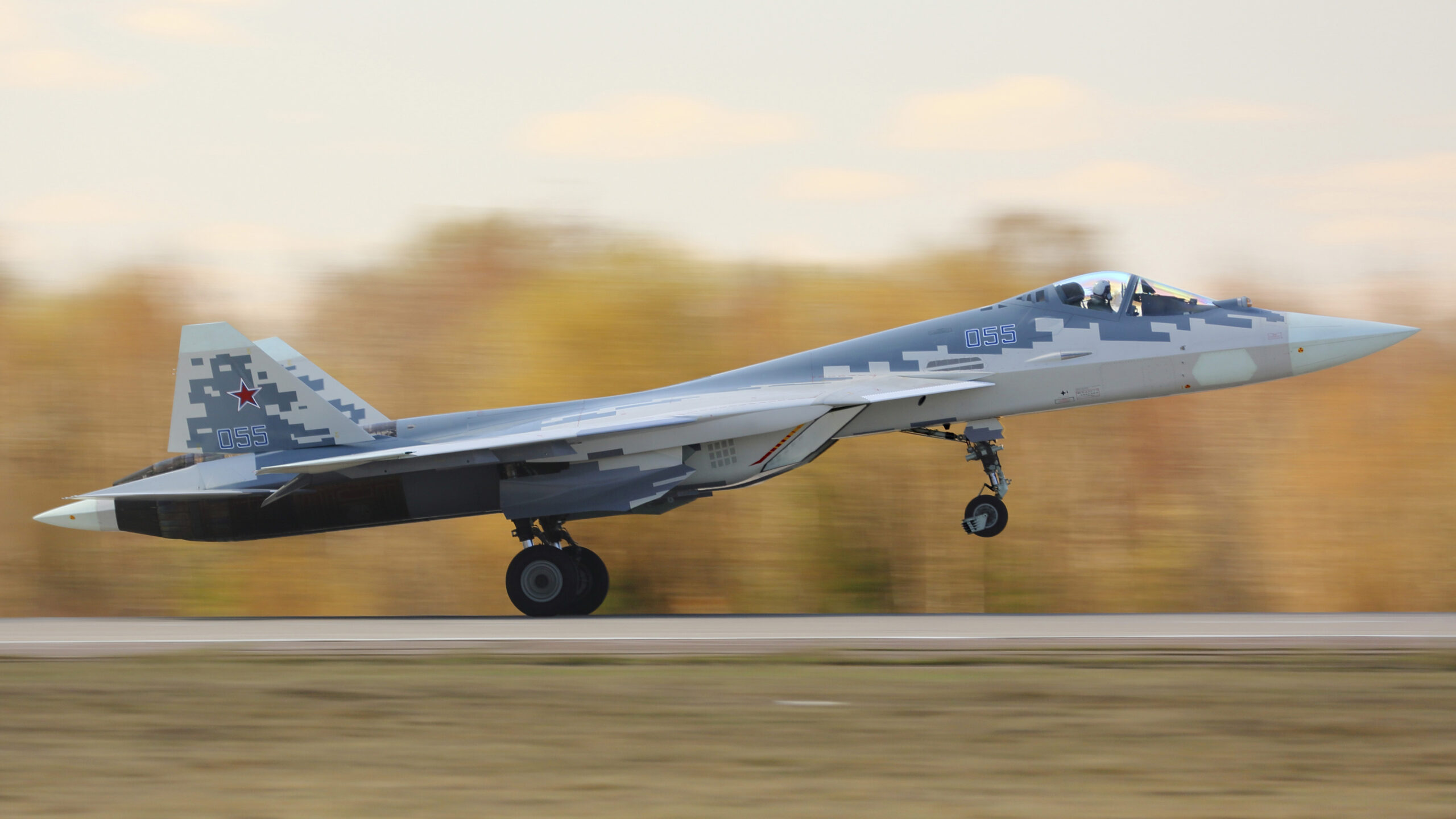
As well as the aforementioned TASS report, which suggested that Su-57s had been used in the war from two to three weeks after the launch of the large-scale invasion on February 24 last year, in October, Gen. Sergey Surovikin, commander in overall charge of the Russian invasion, also alluded to the Felon’s combat use. He noted that the Su-57, “having a wide range of weapons, in each sortie solves multifaceted tasks of destroying air and ground targets.”
Currently, only a very small fleet of Su-57s is available, comprising eight to nine series-production examples, as well as 10 test examples, some of which may well not necessarily even be fully equipped for combat operations.
With that in mind, the Felon is hardly going to be a game-changer in the Ukrainian war, although a combat deployment, even on an experimental basis, would yield very valuable results in terms of evaluating the aircraft’s performance and that of its sensors and weapons, some of which are also new.
There is also a precedent for this kind of combat trial, in the brief deployment of two prototype Felons to Khmeimim Air Base in Syria. It was only after initial reports that the Su-57 had been deployed to Syria that the Russian Ministry of Defense confirmed that fact and provided more details, including that the jets performed “more than ten flights” there. Official video released subsequently suggests that the Su-57s also released at least one example of the Kh-69 missile.
Official Russian Ministry of Defense video showing Su-57 combat trials in Syria in 2018:

As well as proving the capabilities of the Su-57 in a real-world combat environment — and a far more challenging and dynamic one than in Syria — involvement in the war in Ukraine could also help boost the fighter’s flagging export potential. A previous plan to co-produce a Su-57 derivative with India collapsed amid concerns over the project’s progress and the aircraft’s capabilities and, since then, foreign interest in the fighter has been lukewarm, at best.
Meanwhile, with the Kremlin so far having placed orders for only 76 series-production Su-57s, it could even be the case that a good combat performance in Ukraine might help secure the fighter’s future in terms of domestic contracts. This is a particular concern right now, with plans for a fully modernized Su-57M with new izdeliye 30 engines having been delayed and, in the meantime, a much more modest series of improvements now being tested on one of the prototypes.
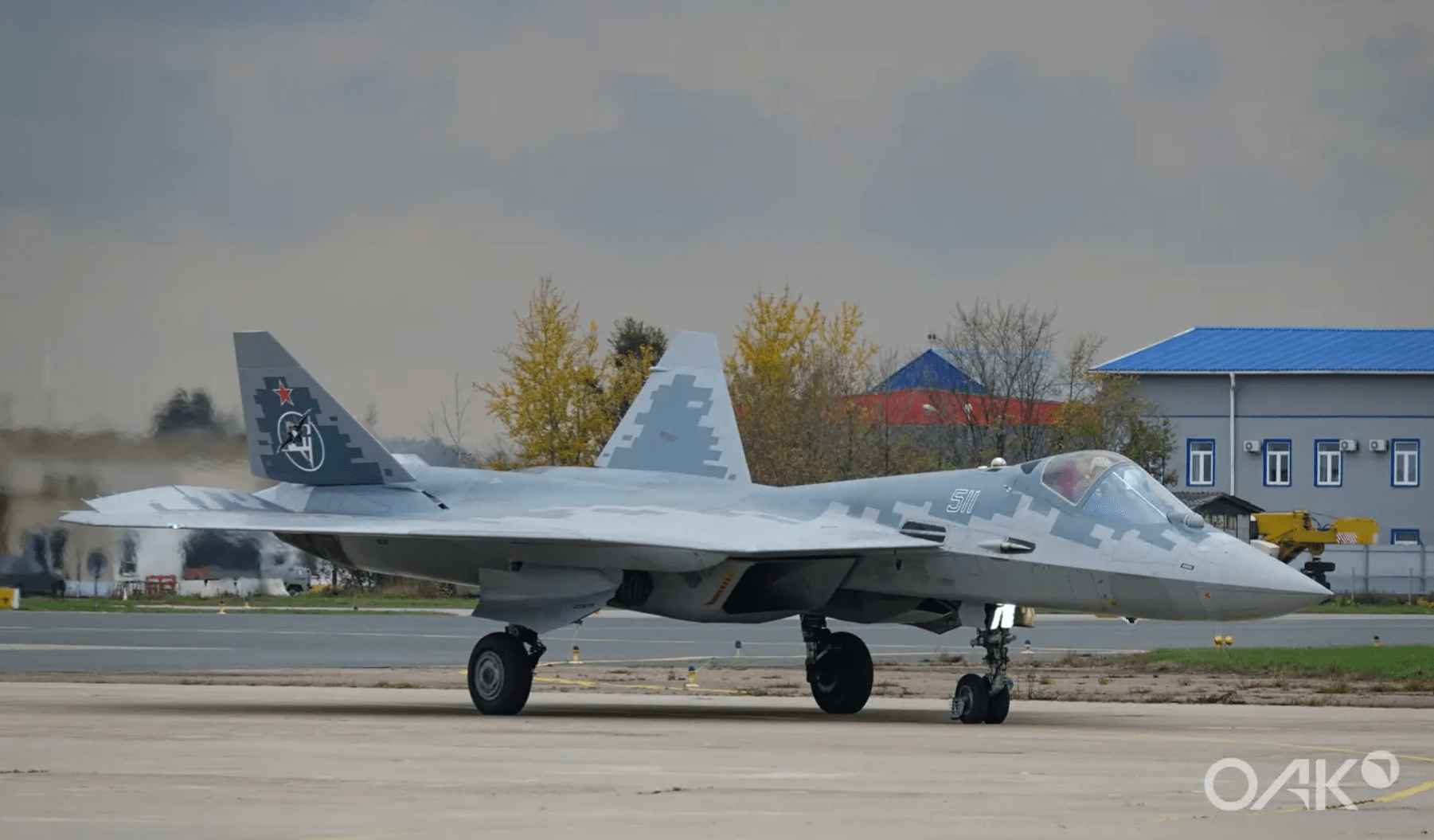
And, as we have pointed out in the past, the prospects of the Su-57’s future success have almost certainly been dealt a blow by the war in Ukraine, with Russia now in a completely new political and economic situation. Russia’s invasion and geopolitical isolation have only decreased those prospects further. As sanctions continue to bite, investment in the tried and tested Su-35S and Su-30SM Flanker series might start to look more attractive than the more costly Su-57.
At this point, we can’t verify for certain that the Su-57 has actually been committed to the war in Ukraine, in whatever capacity, but there’s no doubt that it’s a possibility. If it is indeed being used as described by the U.K. Ministry of Defense, it also underlines just how poorly Russia has performed when it comes to achieving any form of air superiority over Ukraine. Even its top-of-the-line ‘stealthy’ fighter is kept at bay.
Contact the author: thomas@thedrive.com
